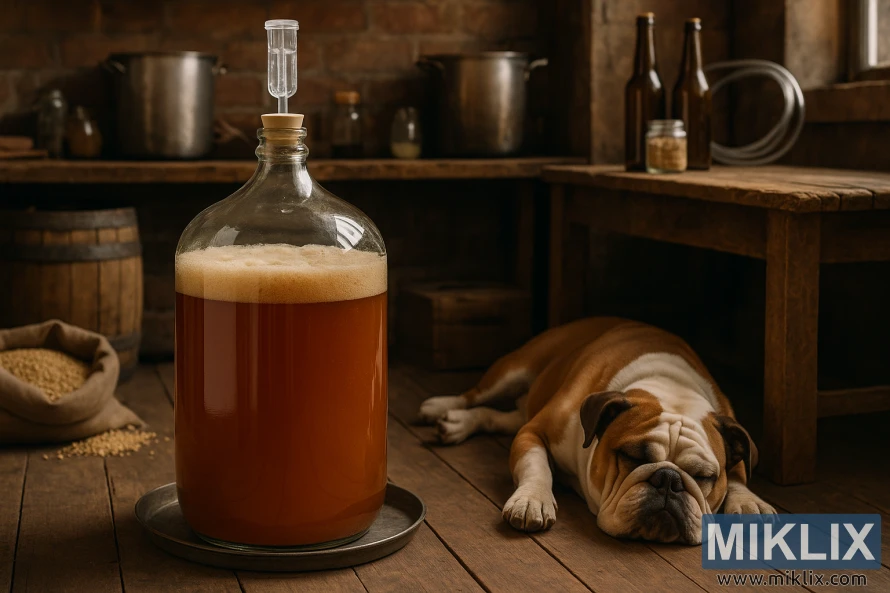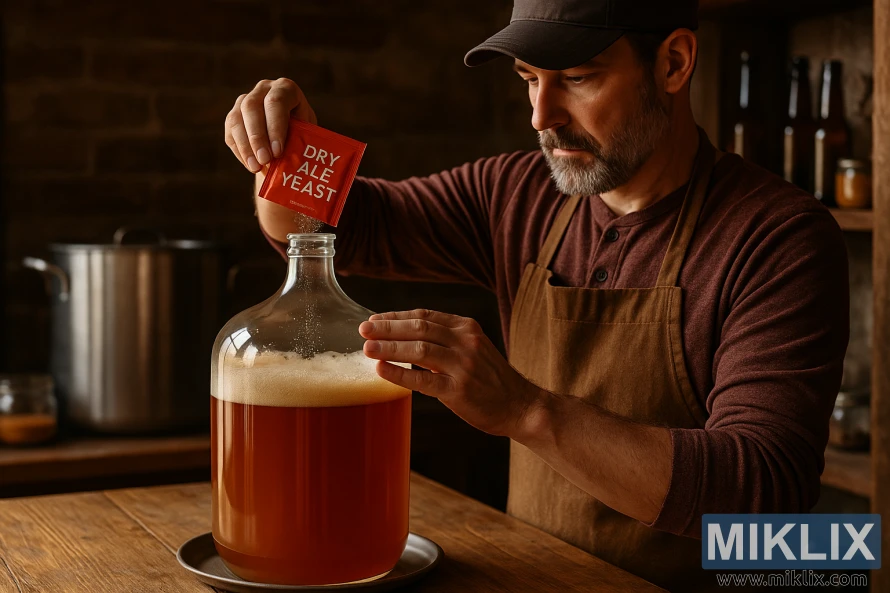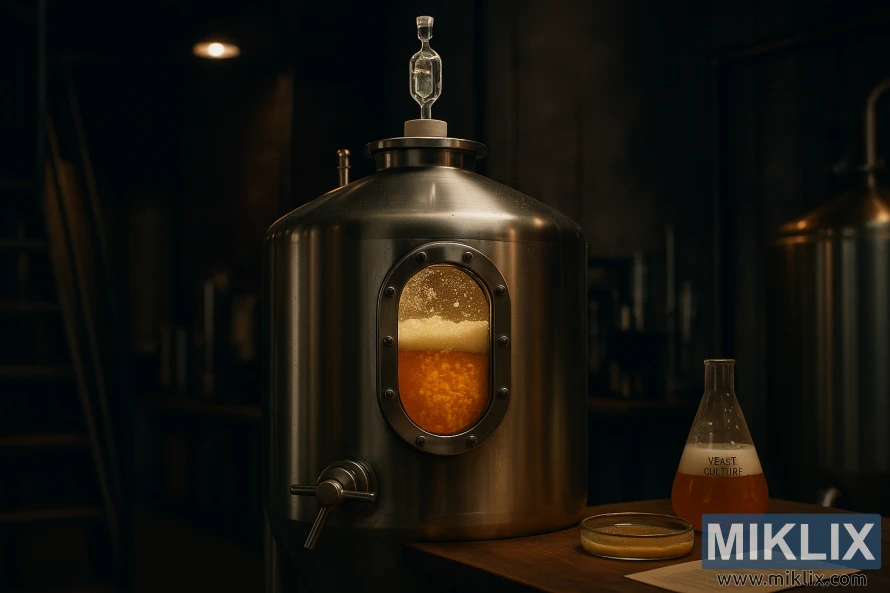Fermenting Beer with Bulldog B5 American West Yeast
Published: October 25, 2025 at 11:41:59 PM UTC
This guide focuses on using Bulldog dry ale yeast, known as Bulldog American West (B5). This yeast is medium-flocculating, offering a clean profile that highlights citrus and tropical hop flavors in American-style ales.

This review and guide will cover various aspects of using Bulldog B5 yeast. Topics include forms and sourcing, pitching and dosage, temperature management, expected final gravity, suitable beer styles, recipe templates, troubleshooting, storage, and tasting notes. The goal is to empower brewers to confidently use American West B5 yeast, whether for small batch runs or larger productions.
Key Takeaways
- Bulldog B5 American West Yeast offers a clean, neutral profile ideal for American IPAs and Pale Ales.
- Expected attenuation is roughly 70–75% with medium flocculation and medium alcohol tolerance.
- Ferment between 16–21°C (61–70°F), targeting ~18°C (64°F) for best balance.
- Available in 10 g sachets (32105) and 500 g bricks (32505) for home and commercial use.
- This guide provides practical pitching, fermentation management, and troubleshooting advice for consistent results.
Overview of Bulldog B5 American West Yeast
Bulldog B5 American West yeast is a dry ale strain designed for American-style beers. It offers a clean, light finish that enhances hop flavors. This yeast is chosen for its ability to highlight citrus and tropical notes without overpowering the beer.
Technical details reveal an attenuation of 70–75%, with a specific instance at 73.0%. The yeast has a medium flocculation rate, ensuring moderate clarity and retaining enough yeast for conditioning. It tolerates medium alcohol levels, fitting most standard-strength ales.
Recommended fermentation temperatures range from 16–21°C (61–70°F), with 18°C (64°F) as the ideal. This temperature range helps the yeast produce balanced esters and a neutral base. It keeps the beer's focus on hop aroma and malt balance.
The yeast's behavior is predictable: it flocculates moderately, leaving some yeast in suspension for better mouthfeel. Its attenuation range leaves a hint of malt sweetness, reaching typical ale finishing gravities. These characteristics make the Bulldog dry ale profile versatile and appealing.
Its use is best suited for brewers aiming to create classic American ales with a hop-forward character. Paired with pale malts and modern American hop varieties, it supports bright, clean expressions of citrus and resin. This enhances hop complexity without overshadowing it.
Why Choose Bulldog B5 American West Yeast for American-style Ales
Bulldog B5 American West yeast is perfect for showcasing hops. It leaves a clean finish, enhancing citrus and tropical hop notes in IPAs and pale ales.
The strain exhibits medium attenuation, around 70–75%. This ensures beers dry out enough to balance bitterness while maintaining a malt backbone. This balance is crucial for American-style ales, which need body to support heavy hopping.
Flocculation is in the medium range, facilitating beer clarification without stripping away character. It also has a medium alcohol tolerance. This makes Bulldog B5 suitable for standard IPAs and larger DIPA recipes, offering brewers flexibility in strength.
Homebrewers and small craft operations appreciate the dry format for its shelf life and ease of rehydration. The availability of pack sizes makes sourcing this reliable, consistent strain straightforward.
Opt for this yeast when aiming for hop clarity and minimal esters. The benefits include clean fermentation, predictable attenuation, and a neutral profile. This allows new American hop varieties to shine.
Product Forms, Packaging, and Availability
Bulldog B5 is available in two primary formats for homebrewers and commercial brewers. The Bulldog 10g sachet is ideal for single batches of 20–25 L (5.3–6.6 US gallons). On the other hand, the Bulldog 500g brick is preferred for larger batches and repeated use by commercial operations and brewpubs.
Pack codes simplify the ordering process. The Bulldog 10g sachet is identified by item code 32105, while the Bulldog 500g brick is item code 32505. These codes assist retailers in inventory management and ensure the correct product is delivered to customers.
The packaging of Bulldog yeast offers significant advantages. The Bulldog yeast sachet provides precise dosing and minimizes waste. In contrast, the Bulldog vacuum brick enhances shelf life by reducing air exposure, ensuring viability during transport and storage.
Retail availability varies among vendors. Homebrew shops typically stock the Bulldog 10g sachet. Wholesale suppliers and ingredient distributors cater to breweries with bulk orders of the Bulldog 500g brick. Online stores offer both options with the option for cold shipping at checkout.
Proper storage is crucial to maintain yeast performance. It is recommended to keep dry yeast in a cool, dry environment. Refrigeration or storage in a cool, dark place before use helps preserve cell viability, whether using a Bulldog yeast sachet or a Bulldog vacuum brick.
- Formats: single-dose Bulldog 10g sachet and bulk Bulldog 500g brick.
- Item codes: 32105 for the 10 g sachet, 32505 for the 500 g brick.
- Storage: cool, dry, and dark; refrigeration recommended for longer shelf life.
- Use cases: homebrew dosing with sachets, production-scale batching with vacuum bricks.
Dosage and Pitching Recommendations
For a standard 20–25 L (5.3–6.6 US gallon) batch, use one 10 g sachet. This Bulldog B5 dosage suits most homebrew American-style ales and matches common 5–6 gallon batch sizes.
Direct pitching is the usual approach. Sprinkle the dry yeast evenly on the wort surface at packaging temperature. This simple method explains how to pitch Bulldog B5 without added equipment or lengthy prep.
For larger volumes or high-gravity worts, increase cell count. Consider a starter or rehydration to boost fermentation vigor. Rehydrating in sterile water at manufacturer-recommended temperature can improve viability when extra cells are needed.
- Standard batch: 10 g sachet per 20–25 L.
- Larger batches: scale dosage or use a 500 g brick for repeated fills.
- High gravity: add a starter or rehydrate to raise active cell count.
Storage affects viability. Keep Bulldog B5 cool and check the manufacture date before use. Poor storage lowers the effective pitching rate and may require higher Bulldog B5 dosage or rehydration.
Practical pitching steps:
- Confirm wort temperature and gravity.
- Open sachet and sprinkle yeast across the wort surface for direct pitching.
- For larger or stronger worts, prepare a starter or rehydrate per standard dry yeast practice.
Following these guidelines keeps the Bulldog B5 pitching rate consistent and helps ensure steady fermentation. Adjust dosage based on batch size, gravity, and storage history to maintain optimal yeast performance.

Fermentation Temperature Management
To achieve the best results, maintain the Bulldog B5 fermentation temperature between 16–21°C (61–70°F). This range allows the American West yeast to ferment steadily, avoiding harsh fusels. It's crucial for the strain's performance.
Opt for a temperature of 18°C when aiming for a balanced ester character and high attenuation. This middle ground often results in a clean finish with a hint of fruitiness, ideal for American-style ales.
For increased fruity esters and faster fermentation, aim for temperatures closer to 21°C. On the other hand, cooler conditions around 16°C will reduce esters, leading to a cleaner profile. The choice depends on your recipe's needs.
Accuracy in temperature control is paramount. Utilize an insulated fermenter, a temperature-controlled chamber, or a climate-stable environment to maintain the wort within the recommended range.
- Measure wort temperature, not just room air.
- Watch airlock activity, but rely on a thermometer for accuracy.
- Use gentle cooling or warming during active fermentation to avoid swings.
Consistent temperature management enhances attenuation and predictability. Proper temperature control allows the yeast to express its intended character, minimizing off-flavors caused by stress.
Attenuation, Flocculation, and Final Gravity Expectations
Bulldog B5 attenuation usually ranges from 70 to 75%, with one instance near 73.0%. This range serves as a solid starting point for brewers planning their recipes. It helps in estimating the expected final gravity.
Using the attenuation range, brewers can predict the residual sugars in their beer. For instance, a wort with an original gravity of 1.050, fermented at 72% attenuation, will likely finish at 1.013. This final gravity contributes to a balanced mouthfeel in many American-style ales.
- Calculate projected FG from OG and percent attenuation to set mash targets.
- Lower mash temperatures add fermentable sugars and drop final gravity.
- Higher mash rests retain dextrins and raise perceived body.
Bulldog B5 flocculation is classified as medium. This means the yeast will settle moderately after fermentation. Expect decent clearing over time. If crystal clarity is crucial, consider a conditioning period or light filtration.
Medium flocculation can impact yeast retention in secondary vessels. When harvesting yeast, take extra care to avoid leaving too little trub. This helps maintain consistent attenuation in future batches.
When adjusting mouthfeel, consider both attenuation and expected final gravity. A 70–75% attenuation range typically results in modest residual sweetness. This balances hop bitterness in hop-forward beers without being cloying.
Practical steps for predictable results:
- Record mash temperature and adjust by 1–2°F to tweak FG.
- Confirm fermentation temperature to support the strain's performance.
- Allow a 3–7 day conditioning window for medium flocculation to clear the beer.
Track OG and final readings to refine your future estimates of Bulldog B5 attenuation and expected final gravity. Consistent metrics enable you to shape the body, finish, and clarity of your beer to match your desired style.

Best Beer Styles to Brew with Bulldog B5 American West Yeast
Bulldog B5 is perfect for hop-forward American-style ales. It offers a clean fermentation profile and medium attenuation. This allows citrus and tropical hop notes to shine, while keeping malt character in the forefront.
For single- and multi-hop IPAs, Bulldog B5 IPA is the go-to choice. It prioritizes bright hop aroma and crisp bitterness. The yeast ensures a dry palate, showcasing late-hop additions and dry-hopping work.
Bulldog B5 pale ale is ideal for balanced American pale ales. It provides a neutral yeast base but retains some malt body. This strain supports caramel or biscuit malts, ensuring a drinkable finish.
For high-impact brews, Bulldog B5 DIPA is a top pick. It tolerates higher gravities and ferments steadily. This allows juicy hop flavors to dominate without harsh solvent notes.
- IPA: emphasize late hops and dry-hop schedules with Bulldog B5 IPA.
- American Pale Ale: use Bulldog B5 pale ale to highlight malt-hopped balance.
- Double IPA: formulate hop bills around Bulldog B5 DIPA to keep the profile clean at higher ABV.
- American-style ales: adapt recipes from session to big beers where yeast neutrality is needed.
Bulldog B5 is suitable for small homebrew batches, using 10 g sachets. It scales up for production with vacuum brick packs. Ensure consistent results across styles by matching pitching rates and oxygenation to batch size.
Recipe Examples and Brewing Templates
Begin by setting the yeast's attenuation at 70–75% and its ideal fermentation range at 16–21°C. Opt for 18°C as the sweet spot. For a 20–25 L batch, a single 10 g sachet is sufficient for standard gravity ales. Design the mash to hit an original gravity that anticipates the expected final gravity. This balance ensures both malt body and hop brightness are preserved.
For single-hop American pale ales, select citrus-forward varieties like Citra, Amarillo, or Cascade. These hops complement the clean, slightly fruity profile of Bulldog B5. Use a moderate bittering addition and split later additions to enhance hop aroma without overshadowing yeast character.
When crafting an IPA recipe with Bulldog B5 for a 20 L batch, aim for an OG in the 1.060–1.070 range for a single IPA. Double IPAs should have higher OGs, necessitating a larger pitch or stepped oxygenation for healthy attenuation. Expect the yeast to leave the beer moderately dry, which amplifies hop intensity.
Utilize this Bulldog B5 brewing template as a starting point:
- Batch size: 20 L (5.3 US gal)
- OG target: 1.060 (single IPA) to 1.080+ (DIPA)
- Mash: 65–67°C for balanced body or 63°C for drier finish
- Fermentation: 18°C target, allow rise toward 20°C for attenuation
- Pitching: 10 g sachet per 20–25 L; rehydrate or make a small starter for higher gravity
- Hops: Citra, Amarillo, Mosaic, Centennial, Cascade
Plan the hop schedule to emphasize late additions and whirlpool for aroma. For high-gravity batches, add oxygen at pitching and consider a step-up in pitch rate to maintain healthy fermentation. Monitor gravity daily until activity slows, then rest the yeast at the higher end of the temperature range to finish attenuation.
For homebrewers crafting Bulldog B5 recipes, keep detailed notes on mash profile, pitch method, and temperature control. Small adjustments to mash temperature or hop timing can significantly alter perceived maltiness and hop clarity. Use the template above to scale to other batch sizes while maintaining the yeast’s preferred conditions.
Fermentation Timeline and Process Monitoring
Primary activity with Bulldog B5 begins within 12–48 hours, once wort is in the right range. Keeping the temperature between 16–21°C is crucial. It helps control ester production and ensures steady attenuation. Watch for airlock activity and krausen rise in the first 3–5 days.
Regular gravity readings are key to tracking the Bulldog B5 fermentation timeline. Take measurements every 24–48 hours until the gravity consistently drops. Expect attenuation to reach 70–75% based on original gravity and pitch rate.
To monitor fermentation with Bulldog B5, combine hydrometer or refractometer checks with temperature readings. This combination offers a more detailed view of yeast health and progress. Small temperature changes can significantly impact flavor and final gravity.
For effective fermentation monitoring, observe krausen formation and decline, yeast sedimentation, and airlock patterns. When gravity readings near the expected range and remain stable for two readings 48 hours apart, primary fermentation is likely complete.
After primary fermentation, allow a conditioning period for the medium-flocculating B5 yeast to settle. This step helps mellow flavors. Keep the beer at a slightly cooler temperature for a few days to a week. This aids in yeast finishing cleanly and clarifying the beer.
Use a simple checklist for process control:
- Start temperature: 16–21°C.
- First gravity check: 24–48 hours after active fermentation begins.
- Regular checks: every 24–48 hours until readings stabilize.
- Conditioning: hold at cooler, stable temperature for several days after primary.
Keeping consistent records simplifies reproducing results and troubleshooting if fermentation slows. Effective monitoring reduces uncertainty and ensures the desired profile for American-style ales brewed with Bulldog B5.

Alcohol Tolerance and High-Gravity Fermentation
Bulldog B5 alcohol tolerance is medium. It excels with standard-strength ales and can handle higher-gravity ferments with proper support. Yet, it's not a high alcohol strain, so gravity limits apply.
To work with Bulldog B5 in high-gravity beers, make adjustments to protect the yeast. Increase the pitch rate to reduce stress and ensure a strong cell count. Thoroughly oxygenate the wort before pitching to enhance biomass and fermentation vigor.
When brewing DIPA with Bulldog B5, consider nutrient support and staggered additions. These strategies help maintain fermentation activity and prevent stalled or sluggish attenuation in high OG worts.
- Pitch more yeast than you would for a standard ale.
- Oxygenate well and add free amino nitrogen if the malt bill is low.
- Keep fermentation temperatures controlled to prevent off-flavors while allowing attenuation.
Practical limits are crucial. While DIPA is compatible, monitor gravity drop and yeast health closely during peak alcohol production. Be ready to boost oxygen or nutrients and adjust temperature if fermentation slows.
For successful DIPA fermentation with Bulldog B5, focus on the process. A larger pitch, staged nutrients, and consistent temperature control are key. These steps help this medium-tolerance yeast reach its full potential in high-gravity beers.
Certifications, Labelling, and Sourcing Notes
Bulldog B5 certifications include kosher designation and EAC recognition. These marks are usually found near the ingredient panel on packaging. This allows buyers to confirm compliance at the point of purchase.
For procurement, common item codes are used to track stock. The 10 g sachet is coded 32105, while the 500 g vacuum brick is coded 32505. It's important to record these codes when ordering to avoid mix-ups between retail and bulk formats.
White-label products can complicate sourcing. Some manufacturers offer lower-cost rebrands that may differ in strain handling or freshness. It's crucial to verify supplier clarity before making bulk purchases to ensure product consistency and traceability.
Confirm the kosher status of Bulldog yeast on the label or via vendor documentation if dietary certification is important for your brewery or kitchen. Request certificate copies when necessary to meet regulatory or customer requirements.
When evaluating Bulldog B5 sourcing, check storage conditions and manufacture date. Dry yeast viability decreases with time and heat. Ensure that sellers store stock refrigerated or in climate-controlled locations and ship promptly.
Bulldog EAC certification is essential for sales in Eurasian markets. Confirm that specific lots list the EAC mark to avoid compliance gaps when exporting or distributing across borders.
When buying for production, inspect seals and vacuum integrity on the 500 g brick. For single-batch use, the 10 g sachet code 32105 offers clear lot tracking and reduced exposure once opened.
Keep procurement records that note Bulldog B5 sourcing, certifications, supplier contact, and lot numbers. This practice helps maintain quality control and speeds recall response if any labelling or certification questions arise.
Storage, Handling, and Reuse Guidelines
Store unopened dry packs in a cool, dark spot to preserve their viability. Refrigeration is ideal for Bulldog B5 storage. Always verify the manufacture and expiry dates before use.
When storing Bulldog yeast cool, maintain a consistent temperature. A fridge between 35–45°F is better than a room with fluctuating temperatures. Chilled, vacuum-sealed bricks retain their potency longer.
Direct pitching by sprinkling dry yeast on wort works well for many brewers. Rehydration is optional for this strain. If you decide to rehydrate, follow the manufacturer's instructions for safe handling.
- Sanitize all utensils and hands before touching yeast.
- Avoid contaminating open packs; transfer only what you need.
- Keep opened packs sealed in an airtight container and refrigerated.
Guidance on reusing dry strains is limited. For reusing Bulldog B5 yeast, monitor viability and cell health across generations. Repeated repitches can reduce vigor and alter performance.
For multiple repitches, consider building a starter or propagating from bulk vacuum packs. Test gravity and fermentation times to detect declining yeast health early.
Packaging shelf life depends on storage. Proper Bulldog B5 storage can maintain performance until the printed expiry. If fermentation slows or off-flavors appear, retire the culture and use a fresh pack.
Common Fermentation Issues and Troubleshooting
Stuck fermentations often result from low pitching rates or insufficient wort oxygenation. To address fermentation stuck with Bulldog B5, boost the pitch rate. Also, ensure good oxygenation before pitching and consider adding a yeast nutrient for essential minerals.
High original gravities can stress yeast, which is a concern for Bulldog B5's medium alcohol tolerance. For high-gravity beers, consider a larger starter or a second pitch. Proper rehydration of dry yeast or using a fresh pack can also prevent viability issues.
Temperature control is critical. Fermenting outside the 16–21°C range increases the risk of unwanted esters and fusel production. Aim for temperatures near 18°C to minimize off-flavors and maintain a clean profile.
Slow activity may indicate a stalled fermentation. Confirm this by checking gravity readings over 48 hours. Gently warming the fermentation area to the upper end of the range and rousing the yeast can help. Only add a small oxygen pulse early in fermentation; adding it later can harm flavor.
Moderate flocculation can result in some haze. For clearer beer, extend conditioning time in the fermenter or lagering phase. Use fining agents or a light filtration step if clarity is crucial.
- Signs of low viability: long lag, weak krausen. Remedy: larger pitch, rehydration, or fresh yeast.
- Temperature-related off-flavors: warm fermentation. Remedy: move to cooler space, use temperature control tools.
- Stuck fermentation steps: verify gravity, gently raise temp, add nutrient or active yeast if needed.
Smell and taste are essential indicators. Harsh solvent notes or hot alcohols suggest overheating. Adjust your practices to avoid Bulldog B5 off-flavors in future batches.
Keeping records is vital for troubleshooting. Log pitch date, pitch rate, temperature, oxygenation, and gravity. This data will expedite troubleshooting for any Bulldog B5 issues you encounter later.

Tasting Notes, Conditioning, and Carbonation Tips
Beers made with Bulldog B5 often have a light, clean finish. This allows citrus and tropical hop flavors to shine. The yeast's 70–75% attenuation range contributes moderate residual malt sweetness. This balance ensures hops remain vibrant without drying the palate excessively.
After primary fermentation, a clear conditioning period is crucial. The medium flocculation of Bulldog B5 means yeast settles well. Yet, time is needed for flavors to blend and harsh esters to dissipate. Cold conditioning for a week or more enhances clarity and smooths the finish.
When conditioning Bulldog B5 beer, keep an eye on gravity to ensure stability before packaging. Stable final gravity minimizes the risk of overcarbonation in bottles or kegs. Adequate time at cellar temperatures refines hop aroma and rounds out the mouthfeel.
Adhere to style-specific carbonation targets. For many American IPAs, aim for 2.4–2.7 volumes CO2. This preserves hop lift and provides a lively mouthfeel. Proper carbonation with Bulldog B5 ensures aromas aren't overwhelmed by excessive fizz and maintains a satisfying head.
Always confirm fermentation completion before bottling or kegging. Verify final gravity over several days. Then, prime or force carbonate to the desired volume. Timely carbonation with Bulldog B5 prevents bottle bombs and preserves the beer's texture.
- Serving temp: serve slightly chilled to highlight hop aromatics without muting aroma compounds.
- Cold crash: one to two days speeds drop-out and clarity.
- Carbonation range: 2.4–2.7 vols for many hop-forward ales; lower for malt-forward styles.
These practical steps, combined with the yeast's clean profile, result in beers that highlight citrus and tropical hops. They maintain a smooth, balanced mouthfeel.
Conclusion
Bulldog B5 American West Yeast is a valuable asset for homebrewers aiming at American-style ales. It offers a clean, light finish with medium attenuation (70–75%) and moderate flocculation. It also has enough alcohol tolerance for IPA, APA, and DIPA recipes. This yeast's performance and flavor neutrality make it ideal for showcasing hop character.
For consistent results, use a 10 g sachet for 20–25 L (5.3–6.6 US gallons) of beer. You can either sprinkle it directly or rehydrate it first. Aim for fermentation temperatures between 16–21°C, preferably around 18°C. Keeping the yeast cool before use ensures consistent attenuation and a predictable mouthfeel.
When considering Bulldog American West, also look at sourcing and certifications. The yeast is available in 10 g sachets (item code 32105) and 500 g vacuum bricks (item code 32505). It holds Kosher and EAC certifications. It's important to verify vendor transparency, as some may use white-label arrangements. Confirm their storage and supply-chain practices before making a purchase.
In summary, this strain is versatile, easy to manage, and perfect for hoppy American ales. Brewers looking for a neutral, dependable dry ale yeast will appreciate its consistent, market-ready performance. The review of Bulldog B5 yeast and the final verdict both highlight its strengths.
Further Reading
If you enjoyed this post, you may also like these suggestions:
- Fermenting Beer with Lallemand LalBrew Köln Yeast
- Fermenting Beer with Wyeast 3726 Farmhouse Ale Yeast
- Fermenting Beer with Lallemand LalBrew Abbaye Yeast
